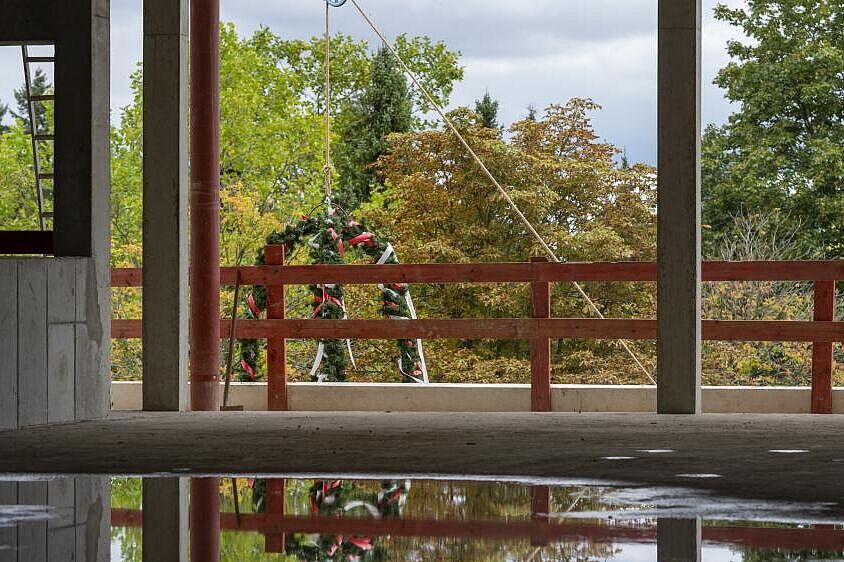Attended and celebrated by about 70 people involved and guests on the Dahlem research campus, including representatives of the two cooperation partners, the Forschungsverbund Berlin e.V., the Berlin Senate Chancellery, the architect's office and the construction companies. Of course, everyone was proud of the new building and is looking forward to the closer collaboration between IGB and FUB.
“When I look at the construction site, I already imagine life, collaboration, a meeting place for science, enthusiasm and fun,” said IGB Director Luc De Meester in his welcome address. Indeed, the Institute is very happy about the new building, because space in the current facilities has become tight. But above all – and more importantly – IGB is looking forward to the closer collaboration with the Freie Universität Berlin.
The new building will be home to collaborative research on aquatic and terrestrial systems, involving molecular and microbial work as well as evolutionary ecological research, global analyses of biodiversity and spatial analyses of physical and ecological connectivity. “We will gain insights here into how biodiversity and global change are connected, including urbanisation and climate warming,” De Meester envisioned.
New space for over 100 researchers and students
The kind of collaboration between universities and non-university research institutions embodied by the new building is a win-win situation for both parties. When it is completed in 2023, more than 100 biodiversity researchers and students will move in and benefit from the close collaboration – also in terms of space – between university and non-university research. This also includes the activities of the Berlin-Brandenburg Institute of Advanced Biodiversity Research (BBIB). And the Berlin Center for Genomics in Biodiversity Research (BeGenDiv) will also find its place here. The central element of the building is a large laboratory landscape surrounded by diverse meeting and lounge areas as well as offices.
Dr. Jutta Koch-Unterseher, Head of the Higher Education and Research Department of the Berlin Senate Chancellery and Chairwoman of the Board of Trustees of the Forschungsverbund Berlin e.V., emphasised in her speech that Berlin is also looking forward to the new building: “The joint science building is dedicated to important topics of the future, both in the construction phase and in the scientific work, that will be done here later. Climate change, species extinction, deforestation of rainforests, scarcity of resources, overpopulation, environmental pollution, responsible action – these are essential topics of our time that are currently more than ever in the public focus. I am firmly convinced that increased scientific engagement in these areas can have positive effects for our social future.”
For more sustainability, also in construction
Sustainable use of energy and resources was and still is important to those involved in the construction. Therefore, durable and recyclable building materials are used and a changeable room concept is being implemented. During a tour through the building shell, architect Johannes Löbbert (Glass Kramer Löbbert bda - Gesellschaft von Architekten) explained to those present that it had been important to the team that the building ideally fit the intended use, but can also meet changing requirements and forms of use over the decades. At the same time, it was important to mediate architecturally between the existing residential structure and the campus grounds. This is how the striking pentagonal floor plan came about.
The research building will be one of the first to be awarded the Gold quality level according to the Assessment System for Sustainable Building for federal buildings. “This shows in an impressive way that Berlin as a science location not only shines through the top performance of its excellent science and research facilities, but also through compliance with the highest sustainability standards,” said Koch-Unterseher, surely expressing well what all guests present felt.


